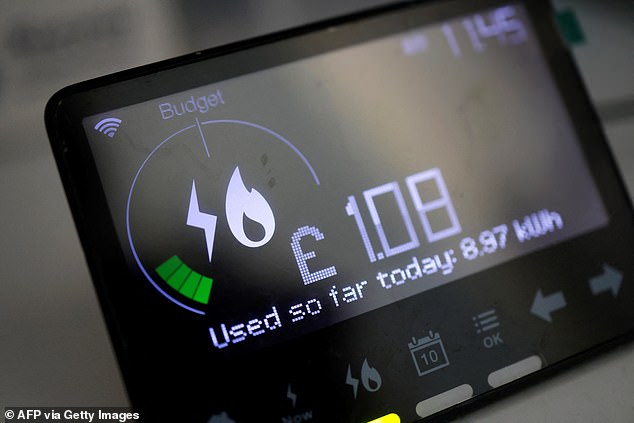Balancing precariously on the edge of a church organist’s stool, it is a challenge to read the electricity meter installed nine feet above in the alcove.
Reverend Jane Held stares up, alongside retired electrical engineer Chris Ramsay, 75. Unfortunately, the church’s insurance will not cover either of them to climb to read this smart meter – but I am happy to step in.
I tap a tiny keypad by the display and Chris tells me to press ‘9’ for a reading. An array of strange messages pop up – ‘using now’, ‘exp kvarh’ and figures zero to ‘3576.126’.
I have been invited to this tiny mission church on the edge of the Peak District to see if I can help solve an energy charge mystery – why electricity bills from Utility Warehouse have been rising from an average of £15 a month to sometimes more than £1,000.
This is for a church that only opens its doors once a month for an hour-long service with a regular congregation of six people.
Church treasurer Pam Ramsay, 68, who is married to Chris, has spent the past year desperately trying to convince the utility giant these ‘nonsensical’ bills must stop.

Yet, despite a visit by one of its engineers last summer, no explanation has been given and monthly bills continue to fluctuate wildly – from as little as £14.59, when Pam complains, to £1,172.
Reverend Jane Held is priest in charge of Saint Mary and Saint John Berkhamsytch in the hamlet of Bottomhouse. It is one of nine churches she looks after.
The vicar says: ‘It simply makes no sense as the church electricity is only turned on for about an hour every month. It is totally unacceptable that a faceless utility giant can continue to take our money without taking a commonsense look at our actual usage.
‘These unbelievable bills get paid from money taken from collection plates passed around at services.’
Reverend Held explains the electricity is only switched on for the 3pm service of hymn and prayer to help warm the congregation.
There are ten single-bar heaters dotted around the building pointing towards the bank of pews. The Staffordshire Moorlands church has no plumbing or running water and is not linked to any other utility service.
Fortunately, I have brought along a power meter that was £20 from Amazon. It plugs into a standard electrical socket – with the electrical item to be tested being plugged into the meter. It shows how much electricity is used by a device and should show how much electricity the church really uses.
Under Chris’s watchful eye, we try it out on a few of the heaters. The readings are consistent – varying between 1,211 watts and 1,217 watts.
Chris says: ‘If the meter shows 1,000 watts it is equivalent to a 1kWh reading. That is the amount of electricity used in an hour – which is the length of time the heaters are on once a month.
‘Multiply this figure by ten to provide a rough idea of just how much electricity is used.’
Going by this calculation, the church is burning about 12kWh every month. Regulator Ofgem says most homes should not be charged more than 25p per kWh.
However, the church is deemed ‘non-domestic’ so the energy supplier gets away with charging 67p per kWh – raising the bill to about £8 when all ten heaters are on for an hour a month. There is also a separate standing charge that, after studying the bills, I see has more than trebled in price.
Last May, Utility Warehouse put it up from 41p a day to £1.26. So, even though the electricity is rarely on (the supply is turned off at the main junction box after every service to ensure no additional use) the standing charge adds £39 to the monthly bill.
This is a huge jump but still works out at less than £50. Yet last year charges were as high as £1,172 in March, £568 charged in February, £385 in August – and most recently for December, £254. In total, the church believes it has been overcharged £3,000 over the past year alone.
Chris says: ‘My wife has explained to Utility Warehouse there is no way we could have used so much electricity.
We would need an illegal cannabis farm growing in the vestry to use up that amount of power.
But Utility Warehouse refuses to listen and says our calculations are ‘over-ridden’ by what the meter tells them. The way the church is being treated feels as if they think we are lying.’

He adds: ‘What is actually going on is hard to fathom because when the meter was installed four years ago everything was fine. As recently as September 2023, we were being charged £14.16.
But then readings started to go haywire. My own suspicion is there is something wrong with the way the meter is sending signals for what is used to the energy supplier.
Radio wave messages are somehow getting scrambled and not properly read – perhaps due to the church being situated in an isolated spot that is far from communication masts.’
Parishioners in Bottomhouse are not alone. Two- thirds of the 30million homes in Britain now have a smart meter.
Although a meter allows energy companies to automatically log your electricity and gas usage via signals sent from the equipment to the supplier – it also means you are unable to manually check that the figures sent from the meter are correct.
Smart meter readings are transmitted from homes – occasionally churches – via a network of mobile phone and radio masts that pass on the received information to so-called Data Communications Company (DCC) servers connected to receivers held by your energy supplier.
Occasionally, energy suppliers have trouble receiving messages due to problems such as thick walls blocking signals, network cover being weak or a Wide Area Network (WAN) connection difficulty on the network. Customers who want to contact their energy provider may find themselves up against endless phone waits or using online ‘chat’ facilities.
So, if you find it hard to resolve a query, send a letter of complaint to your energy provider outlining your concerns and include all details of previous bills, highlighting where you think errors have occurred.
Be aware energy providers may charge for an investigation if it finds the meter is in fact accurate. Expect to pay up to £200.
Energy UK, which represents utility giants installing smart meters, has admitted there is a regional divide in the way signals are sent.
In the Midlands, Wales and southern England, cellular technology similar to mobile phones is used. But in northern England and Scotland, meters rely on longer range radio frequencies. The church’s location may straddle both networks.
Smart meters automatically send energy consumption details to the utility firm – and also offer households more control as they show in near-real time how much energy is being used.
But the £13.5billion rollout that began nine years ago has been blighted with problems. Despite about two-thirds of meters now being deemed ‘smart’, one in ten has gone ‘dumb’ since being fitted, meaning customers have to take readings themselves.
Explanations vary – from older types going dumb on switching supplier, to blocked signals in areas of poor reception, thick home walls and battery failures. The £400 a household cost of the rollout is added to bills.
A Utility Warehouse spokesman says: ‘We are sorry to hear about Mrs Ramsay’s concerns regarding the church’s bills.
‘Following an engineer’s visit, we can confirm the smart meter is working correctly and recording energy usage accurately. Our customer service team has contacted Mrs Ramsay to discuss the account and a payment plan that is manageable for her needs.’
SAVE MONEY, MAKE MONEY
Affiliate links: If you take out a product This is Money may earn a commission. These deals are chosen by our editorial team, as we think they are worth highlighting. This does not affect our editorial independence. Terms and conditions apply on all offers.



